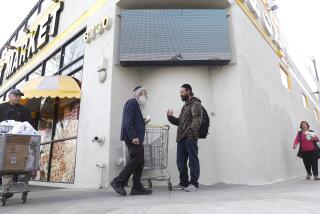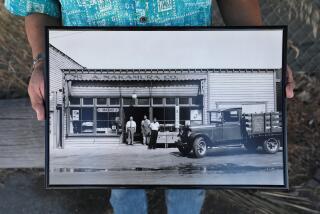DOWNTOWN : Chinese, Jews Mark Intertwined History
- Share via
They came from different lands, spoke different languages and had different customs. But Jewish and Chinese immigrants settled in early Los Angeles about the same time, creating neighboring ethnic enclaves in the Union Station area in the late 1800s.
To recognize and celebrate this parallel and the intertwined development of Chinese and Jewish communities in Los Angeles, the Chinese and Jewish historical societies will hold a joint event today at the historic Merced Theatre on Olvera Street.
Members and friends of the two historical societies will enjoy slide shows of photographs documenting the arrival of Jewish and Chinese immigrants, a buffet of foods from both cultures and guided tours of the buildings in the El Pueblo Historic Monument area.
The El Pueblo-Union Station area has always been a melting pot. It was originally inhabited by Spanish and Mexican immigrants. Chinese and Jewish settlers began to populate the area in the mid- to late 1800s, along with Italians whose “Little Italy” neighborhood was centered in what is now Chinatown. An enclave of French immigrants also inhabited the area, historians say.
Drawn by work on the railroad, Chinese immigrants originally settled where Union Station is now, and many started businesses in the two-story Garnier Building, which still stands at Los Angeles and Arcadia streets.
Chinese businesses set up shop on the first floor of the brick structure and Chinese family associations and community organizations used the second floor.
The original Chinatown, east of Alameda Street, was torn down in the mid-1930s to make way for Union Station.
Residents moved south toward the produce area or to nearby Broadway, Spring and Main streets to form the new Chinatown.
Jewish immigrants settled in what was called “Bell’s Row,” near Aliso and Los Angeles streets, where federal government buildings now stand.
The first Jewish residents were primarily single men drawn by commercial opportunities provided by the city’s growing population. Many became merchandisers, selling clothing, dry goods and groceries, said Lynn Kronzek, a member of both historical societies.
It was Kronzek who came up with the idea for a joint activity, the first between the two historical societies.
“It seemed very obvious to me that they should come together,” Kronzek said.
“The Pueblo was the nexus for both communities.”
The event begins at 2 p.m. and costs $8 for members of either historical society and $10 for non-members.
Reservations: Elmo Gambarana of the Chinese Historical Society at (213) 733-2927 or the Jewish Historical Society at (213) 653-7740.
More to Read
Sign up for Essential California
The most important California stories and recommendations in your inbox every morning.
You may occasionally receive promotional content from the Los Angeles Times.










